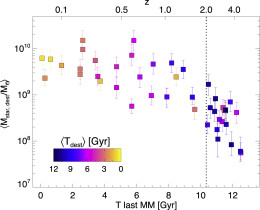We think galactic halos are built through the addition of material from the smaller subhalos of satellites digested by their hosts. Though most of the stars in Milky-Way-mass halos were probably formed in situ, many were instead accumulated over time, as orbiting dwarf galaxies were torn apart and their stars flung throughout the host galaxy. A recent set of simulations has examined this brutal formation process.

In the authors’ simulations, a subhalo first falls into the host halo. At this point, it can either survive to present day as a satellite galaxy, or it can be destroyed, its stars scattering throughout the host halo. [Deason et al. 2016]
Subhalo Fate
There are many open questions about the growth of Milky-Way-mass halos from the accretion of subhalos. Which subhalos are torn apart and accreted, and which ones survive intact? Are more small or large subhalos accreted? Does subhalo accretion affect the host galaxy’s metallicity? And what can we learn from all of this about the Milky Way’s formation history?
In a recently published study, a team of scientists from Stanford University and SLAC National Accelerator Laboratory set out to answer these questions using a suite of 45 zoom-in simulations of Milky-Way-mass halos. Led by Alis Deason, the team tracked the accretion history of these 45 test galaxies to determine how their halos were built.
Piecing Together History
Deason and collaborators reach several new and interesting conclusions based on the outcomes of their simulations.
- Most of the stellar mass accreted by the Milky-Way-mass halos typically comes from only one or two destroyed dwarfs. The accreted dwarfs are usually low-mass if they were accreted early on in the simulation (i.e., in the early universe), and high-mass if they were accreted recently.
- Dwarfs destroyed and accreted early on are typically low-metallicity — as would be expected, since metallicity was lower in the early universe. Dwarfs accreted later in the simulation are typically higher metallicity. So host halos with recent accretion events are not only likely to have accreted more stellar mass, but also probably higher-metallicity stars.
- Though ultra-faint, low-mass dwarfs have lower average metallicities than the larger classical dwarfs, classical dwarfs contribute more of the very metal-poor stars accreted by host halos (40-80%, compared to the 2-5% from ultra-faint dwarfs).
- Halos that have relatively quiescent accretion histories tend to have lower-mass surviving dwarfs today.
A Transient Fossil?
This last point has interesting implications for our own galaxy. The Milky Way is generally though to have a quiescent formation history, and yet it contains two high-mass surviving dwarfs: the Large and Small Magellanic Clouds. The authors suggest that this inconsistency could be resolved if the Milky Way is a “transient fossil” — a halo with a quiescent formation history masked by its recent acquisition of the Large and Small Magellanic Clouds.
The outcomes from this suite of simulations provide important clues for better understanding how our own galaxy — and galaxies like ours — have formed and evolved.
Citation
Alis J. Deason et al 2016 ApJ 821 5. doi:10.3847/0004-637X/821/1/5



1 Comment
Pingback: how galaxy halos grow